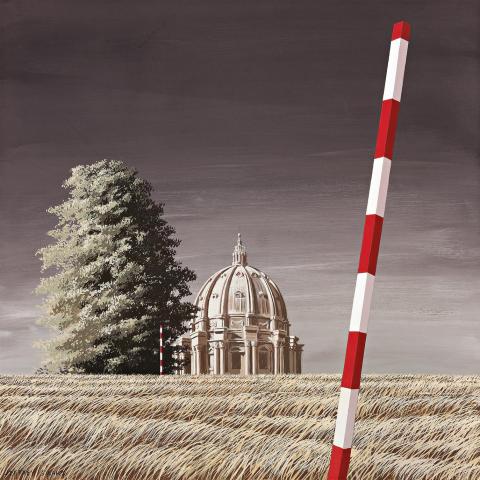THE DOME II, 1978 – 79
JEFFREY SMART
oil and synthetic polymer paint on paper on board
44.0 x 44.0 cm
signed lower left: JEFFREY SMART
Commissioned by Guilford Bell, Melbourne
Private collection, Melbourne
The Dome, 1977, oil and acrylic on canvas, 75.0 x 75.0 cm, in the collection of TarraWarra Museum of Art, Victoria, illus. in Pearce, B., Jeffrey Smart, The Beagle Press, Sydney, 2005, p. 138
The Dome, c.1979, colour aquatint, 48.5 x 48.0 cm, edition of 100, an example in the collection of Art Gallery of New South Wales, Sydney
Deutscher and Hackett gratefully acknowledges the assistance of Stephen Rogers, Archivist for the Estate of Jeffrey Smart, in cataloguing this work.
The Dome II, 1978 – 1979 is based on one of Jeffrey Smart’s most difficult compositions, The Dome, 1977. The use of the word ‘difficult’ comes directly from the artist, an absolute perfectionist, who wrote that in spite of the apparent simplicity of the image, ‘almost more than any other painting, the theme would not resolve itself without a great number of studies… the last three studies were exhibited, but all the first ‘try-outs’ have been destroyed’.1 Smart was one of the last classically trained artists in Australia, one who looked more to the Renaissance than any other period as an exemplar of geometric precision and perspective. It is this fidelity to visual truth that conversely makes his paintings so compelling as viewers recognise all the individual components but struggle to make a coherent narrative between them.
After a burgeoning career in Australia, Smart travelled overseas in the early 1960s and finally settled in a rustic farmhouse in Tuscany in 1971. From this base, he travelled widely, taking notes and photographs of stray industrial oddities and situations. Smart recognised the urban milieu as his true subject, a site of random, slightly surreal couplings that stirred his imagination. A realist by nature (‘I don’t want to be Dufy, I want to be Vermeer’.)2, he would produce many preliminary sketches of his projected paintings, honing the composition until it was truly anchored and harmonious. The Dome, 1977, for example, ‘owes its genesis to Smart coming upon surveyors planning building developments in a field which gave a remarkable vista of (the cupola of) St Peter’s (in the Vatican)’.3 Of the surviving studies, (First Study for) The Dome, 1977 shows only the dome and one surveyor’s pole set against the field of grass, whereas the final image includes two poles and a tree that is thick with foliage. What makes the final image unsettling is that the marked measuring sticks are actually of no use to a viewer when attempting to set a scale of proportion within the painting. ‘Near and far have no significance. … We seek to measure distance, to understand our position, estimate scale, locate objects. Yet we are at a loss in this sea of grass, and without secure foundation for the tree, the dome or the foreground pole which we could reach out and grasp’.4 The art critic John McDonald also noted that the cross on the cupola falls at the exact centre of the composition.5 Such was the precision of Smart’s Renaissance vision.
Following its exhibition and sale, Smart was approached by the Melbourne-based architect Guilford Bell who commissioned the artist to do a smaller version of The Dome. In a revealing letter to Bell, Smart wrote: ‘The picture… has been covered with a protective film of non-shining PVA which has brought out the colour beautifully. … It should be stuck down with a water glue on a board’6, and both features are still apparent in The Dome II. Smart also decided to produce a detailed colour aquatint based on the commission, declaring ‘I think it will be beautiful’.7 Produced in an edition of 100, this subsequent rendering proved to be an extremely sought after item in itself.
1. Quartermaine, P., Jeffrey Smart, Gryphon Books, Melbourne, 1983, p. 84
2. Smart, J. letter to Barry Pearce, 21 January 2005, cited in Pearce, B., Jeffrey Smart, The Beagle Press, Sydney, 2005, p. 189
3. Quartermaine, P., op cit., p. 84
4. ibid.
5. McDonald, J., Jeffrey Smart: Paintings of the ‘70s and ‘80s, Craftsman House, Sydney, 1990, p. 30
6. Smart, J. correspondence with Guilford Bell and Denis Kelynack, 20 March 1979, kindly provided by Stephen Rogers, archivist to Jeffrey Smart, 10 May 2017
7. Smart, J., op cit., 20 March 1979
ANDREW GAYNOR
